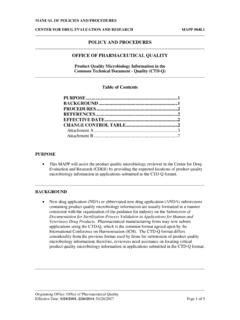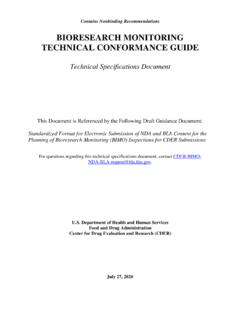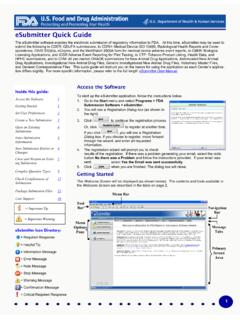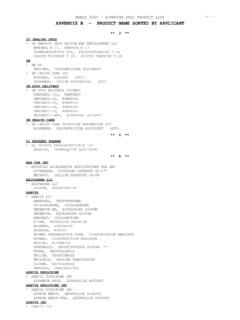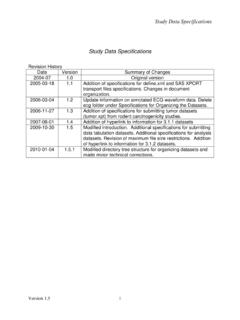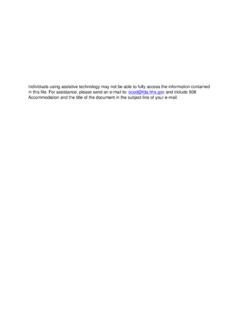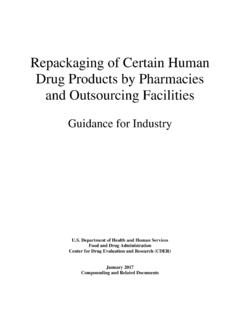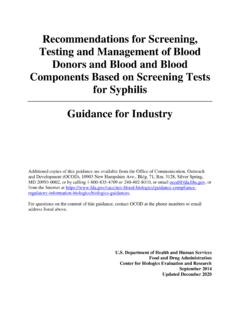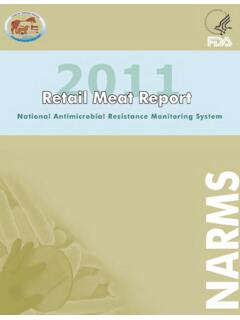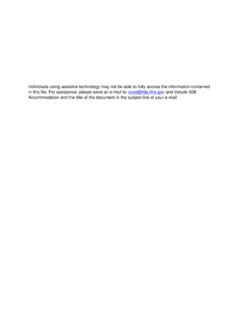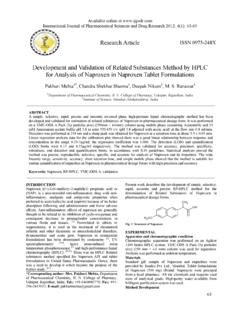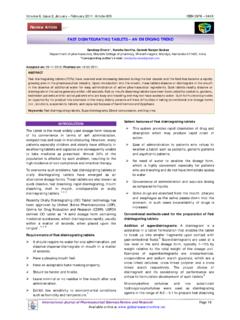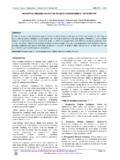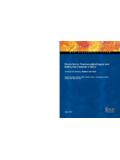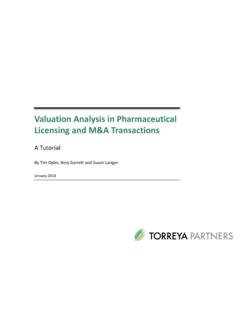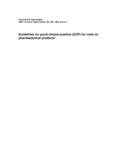Transcription of Guidance for Industry Q10 Pharmaceutical Quality System
1 Guidance for Industry Q10 Pharmaceutical Quality System Department of Health and Human Services food and drug administration Center for drug Evaluation and research (CDER) Center for Biologics Evaluation and research (CBER) April 2009 ICH Guidance for Industry Q10 Pharmaceutical Quality System Additional copies are available from: Office of Communication Division of drug Information Center for drug Evaluation and research food and drug administration 10903 New Hampshire Ave.,Bldg. 51, Room 2201 Silver Spring, MD 20993-0002 (Tel) 301-796-3400 Office of Communication, Outreach and Development, HFM-40 Center for Biologics Evaluation and research food and drug administration 1401 Rockville Pike, Rockville, MD 20852-1448 (Tel) 1-800-835-4709 or 301-827-1800 Department of Health and Human Services food and drug administration Center for drug Evaluation and research (CDER) Center for Biologics Evaluation and research (CBER) April 2009 ICH TABLE OF CONTENTS I.
2 INTRODUCTION (1, ).. 1 II. Pharmaceutical Quality MANAGEMENT System .. 2 A. Scope ( )..2 B. Relationship of ICH Q10 to Regional GMP Requirements, ISO Standards, and ICH Q7 ( )..3 C. Relationship of ICH Q10 to Regulatory Approaches ( )..3 D. ICH Q10 Objectives ( )..3 E. Enablers: Knowledge Management and Quality Risk Management ( ) .. 4 F. Design and Content Considerations ( ) ..4 G. Quality Manual ( )..5 III. MANAGEMENT RESPONSIBILITY (2).. 5 A. Management Commitment ( )..5 B. Quality Policy ( )..6 C. Quality Planning ( )..6 D. Resource Management ( )..7 E. Internal Communication ( ) .. 7 F. Management Review ( )..7 G. Management of Outsourced Activities and Purchased Materials ( )..7 H. Management of Change in Product Ownership ( )..8 IV. CONTINUAL IMPROVEMENT OF PROCESS PERFORMANCE AND PRODUCT Quality (3) .. 8 A. Lifecycle Stage Goals ( ).
3 8 B. Pharmaceutical Quality System Elements ( )..9 V. CONTINUAL IMPROVEMENT OF THE Pharmaceutical Quality System (4) .. 13 A. Management Review of the Pharmaceutical Quality System ( )..13 B. Monitoring of Internal and External Factors That Can Have an Impacton the Pharmaceutical Quality System ( )..13 C. Outcomes of Management Review and Monitoring ( )..14 VI. GLOSSARY (5).. 15 Annex I: Potential Opportunities To Enhance Science- and Risk-Based Regulatory Approaches *.. 18 Annex 2: Diagram of the ICH Q10 Pharmaceutical Quality System i Guidance for Industry1 Q10 Pharmaceutical Quality System This Guidance represents the food and drug administration 's (FDA s) current thinking on this topic. It does not create or confer any rights for or on any person and does not operate to bind FDA or the public.
4 You can use an alternative approach if the approach satisfies the requirements of the applicable statutes and regulations. If you want to discuss an alternative approach, contact the FDA staff responsible for implementing this Guidance . If you cannot identify the appropriate FDA staff, call the appropriate number listed on the title page of this Guidance . I. INTRODUCTION (1, )2 This internationally harmonized Guidance is intended to assist Pharmaceutical manufacturers by describing a model for an effective Quality management System for the Pharmaceutical Industry , referred to as the Pharmaceutical Quality System . Throughout this Guidance , the term Pharmaceutical Quality System refers to the ICH Q10 model. ICH Q10 describes one comprehensive model for an effective Pharmaceutical Quality System that is based on International Organization for Standardization (ISO) Quality concepts, includes applicable good manufacturing practice (GMP) regulations, and complements ICH Q8 Pharmaceutical Development and ICH Q9 Quality Risk Management.
5 3 ICH Q10 is a model for a Pharmaceutical Quality System that can be implemented throughout the different stages of a product lifecycle. Much of the content of ICH Q10 applicable to manufacturing sites is currently specified by regional GMP requirements. ICH Q10 is not intended to create any new expectations beyond current regulatory requirements. Consequently, the content of ICH Q10 that is additional to current regional GMP requirements is optional. 1 This Guidance was developed within the Expert Working Group ( Quality ) of the International Conference on Harmonisation of Technical Requirements for Registration of Pharmaceuticals for Human Use (ICH) and has been subject to consultation by the regulatory parties, in accordance with the ICH process. This document has been endorsed by the ICH Steering Committee at Step 4 of the ICH process, June 2008. At Step 4 of the process, the final draft is recommended for adoption to the regulatory bodies of the European Union, Japan, and the United States.
6 2 Arabic numbers reflect the organizational breakdown of the document endorsed by the ICH Steering Committee at Step 4 of the ICH process, June 2008. 3 These guidances are available on the Internet at We update guidances periodically. To make sure you have the most recent version of a Guidance , check the CDER Guidance page at 1 ICH Q10 demonstrates Industry and regulatory authorities support of an effective Pharmaceutical Quality System to enhance the Quality and availability of medicines around the world in the interest of public health. Implementation of ICH Q10 throughout the product lifecycle should facilitate innovation and continual improvement and strengthen the link between Pharmaceutical development and manufacturing activities. FDA's Guidance documents, including this Guidance , do not establish legally enforceable responsibilities. Instead, guidances describe the Agency s current thinking on a topic and should be viewed only as recommendations, unless specific regulatory or statutory requirements are cited.
7 The use of the word should in Agency guidances means that something is suggested or recommended, but not required. II. Pharmaceutical Quality MANAGEMENT System A. Scope ( ) This Guidance applies to the systems supporting the development and manufacture of Pharmaceutical drug substances ( , active Pharmaceutical ingredients (APIs)) and drug products, including biotechnology and biological products, throughout the product lifecycle. The elements of ICH Q10 should be applied in a manner that is appropriate and proportionate to each of the product lifecycle stages, recognizing the differences among, and the different goals of, each stage (see section IV (3)). For the purposes of this Guidance , the product lifecycle includes the following technical activities for new and existing products: Pharmaceutical Development o drug substance development o Formulation development (including container/closure System ) o Manufacture of investigational products o Delivery System development (where relevant) o Manufacturing process development and scale-up o Analytical method development Technology Transfer o New product transfers during development through manufacturing o Transfers within or between manufacturing and testing sites for marketed products Commercial Manufacturing o Acquisition and control of materials o Provision of facilities, utilities, and equipment o Production (including packaging and labeling) o Quality control and assurance o Release o Storage 2 o Distribution (excluding wholesaler activities) Product Discontinuation o Retention of documentation o Sample retention o Continued product assessment and reporting B.
8 Relationship of ICH Q10 to Regional GMP Requirements, ISO Standards, and ICH Q7 ( ) Regional GMP requirements, the ICH Guidance Q7 Good Manufacturing Practice Guidance for Active Pharmaceutical Ingredients, and ISO Quality management System guidelines form the foundation for ICH Q10. To meet the objectives described below, ICH Q10 augments GMPs by describing specific Quality System elements and management responsibilities. ICH Q10 provides a harmonized model for a Pharmaceutical Quality System throughout the lifecycle of a product and is intended to be used together with regional GMP requirements. The regional GMPs do not explicitly address all stages of the product lifecycle ( , development). The Quality System elements and management responsibilities described in this Guidance are intended to encourage the use of science- and risk-based approaches at each lifecycle stage, thereby promoting continual improvement across the entire product lifecycle.
9 C. Relationship of ICH Q10 to Regulatory Approaches ( ) Regulatory approaches for a specific product or manufacturing facility should be commensurate with the level of product and process understanding, the results of Quality risk management, and the effectiveness of the Pharmaceutical Quality System . When implemented, the effectiveness of the Pharmaceutical Quality System can normally be evaluated during a regulatory inspection at the manufacturing site. Potential opportunities to enhance science- and risk-based regulatory approaches are identified in Annex 1. Regulatory processes will be determined by region. D. ICH Q10 Objectives ( ) Implementation of the Q10 model should result in achievement of three main objectives that complement or enhance regional GMP requirements. 1. Achieve Product Realization ( ) To establish, implement, and maintain a System that allows the delivery of products with the Quality attributes appropriate to meet the needs of patients, health care professionals, regulatory authorities (including compliance with approved regulatory filings) and other internal and external customers.
10 2 Establish and Maintain a State of Control ( ) 3 To develop and use effective monitoring and control systems for process performance and product Quality , thereby providing assurance of continued suitability and capability of processes. Quality risk management can be useful in identifying the monitoring and control systems. 3 Facilitate Continual Improvement ( ) To identify and implement appropriate product Quality improvements, process improvements, variability reduction, innovations, and Pharmaceutical Quality System enhancements, thereby increasing the ability to fulfill a Pharmaceutical manufacturer s own Quality needs consistently. Quality risk management can be useful for identifying and prioritizing areas for continual improvement. E. Enablers: Knowledge Management and Quality Risk Management ( ) Use of knowledge management and Quality risk management will enable a company to implement ICH Q10 effectively and successfully.
